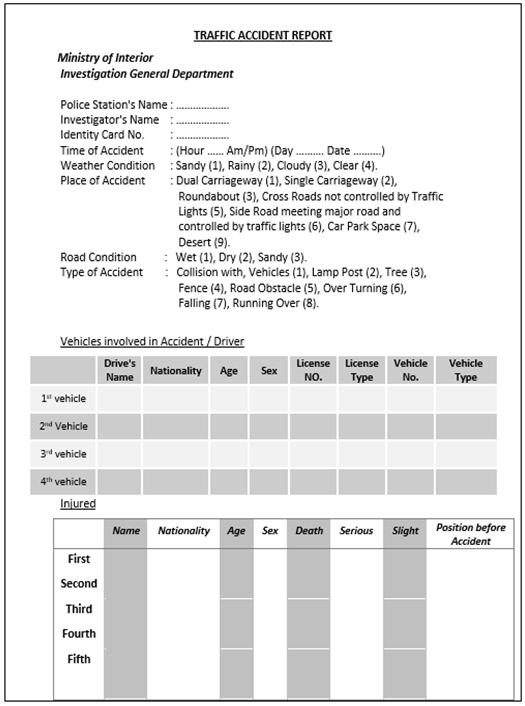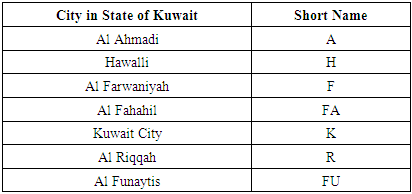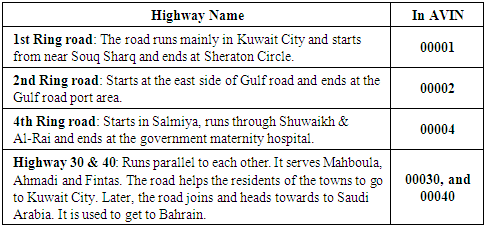-
Paper Information
- Paper Submission
-
Journal Information
- About This Journal
- Editorial Board
- Current Issue
- Archive
- Author Guidelines
- Contact Us
International Journal of Traffic and Transportation Engineering
p-ISSN: 2325-0062 e-ISSN: 2325-0070
2021; 10(1): 20-23
doi:10.5923/j.ijtte.20211001.03
Received: Aug. 10, 2021; Accepted: Aug. 30, 2021; Published: Sep. 15, 2021

Establishment of Vehicle Accident Identification Number (VAIN) in Kuwait
Jasem Alrajhi, Mohsen Alardhi, Ahmad Murad, Muhktar Murad, Khaled Alhafi, Nawaf Alhafi
Automotive & Marine Engineering Technology, College of Technological Studies - PAAET, Kuwait
Correspondence to: Jasem Alrajhi, Automotive & Marine Engineering Technology, College of Technological Studies - PAAET, Kuwait.
| Email: |  |
Copyright © 2021 The Author(s). Published by Scientific & Academic Publishing.
This work is licensed under the Creative Commons Attribution International License (CC BY).
http://creativecommons.org/licenses/by/4.0/

Road transportation entails several risks, including the world's deadliest road accidents. Because of the consequent deaths and taking into consideration their various consequences on social and economic life, traffic accidents and their impacts have become one of the most essential and deadly concerns confronting the community and individuals today. Indeed, several recent attempts to reduce the incidence and severity of traffic accidents have yielded positive results by studying the recorded data of past accidents. This research aims to propose a unified Vehicle Accident Identification Number (VAIN) for each accident in Kuwait based on the accident time, date, vehicle number & other aspects so that the same Vehicle Accident Identification Number can be referred by concerned authorities in the State of Kuwait. In the future this number can be the basis of a database from which the authorities can retrieve the valuable accurate information on a click.
Keywords: Transportation, Traffic accidents, Accident identification number, Database
Cite this paper: Jasem Alrajhi, Mohsen Alardhi, Ahmad Murad, Muhktar Murad, Khaled Alhafi, Nawaf Alhafi, Establishment of Vehicle Accident Identification Number (VAIN) in Kuwait, International Journal of Traffic and Transportation Engineering, Vol. 10 No. 1, 2021, pp. 20-23. doi: 10.5923/j.ijtte.20211001.03.
Article Outline
1. Introduction
- The United Nations (UN) incorporated road safety into its pre-existing sustainable development principles in 2003, owing to the potentially catastrophic outcomes (such as death or injury) that occur because of automobile accidents. Since then, it has been predicted that road fatalities will rise from ninth to third leading cause of death for humans in the next decade (World Health Organization), and that road safety as a general topic has been raised by the UN General Assembly plenary sessions (2004; 2008), during which they also referenced the need to develop a new critical and unconventional necessity to take more serious actions in terms of road safety.Indeed, the current lack of road safety has accounted for 80% of road fatalities within developing countries, even though they only comprise 20% of the total motorised vehicles. This is particularly prominent in Kuwait, as the more fatalities that occur, the more GDP decreases (the Gulf States’ GDP indeed having dropped by an estimated 2.5%-4.5% because of such fatalities). Such losses can be quantified as listed below:• 3%-4% of Kuwait’s yearly GOP has been lost because of fatal road injuries. • The nation’s medical services, resources, and investment plans are drastically affected by the financial pressures generated by road accidents. • 428 road-related deaths, 10305 severe injuries, and a whopping 71161 accidents were documented in 2017. (https://www.moi.gov.kw/gdt/Statistics2.htm#).As can be seen from the above, this is a particularly pressing issue that has the potential to cast a negative ripple effect across Kuwait’s economy. Kuwait is one of the richest developing countries in the world. It has an extremely high rate of vehicle ownership, and a superbly modern highway system, yet it has a very bad record of traffic accidents.The Kuwaiti traffic police force—which, as standard, account for all traffic enforcement, data, and safety information—have reported that the way in which they have to document such accidents is insufficient in the sense that not all the necessary data (e.g., efficient classification of such accidents; any road intersection issues; the things done by the involved drivers directly before the accident; a concrete approach to establishing the specific place in which the accident took place) can be included. This is a critical issue, because it is on this that developed countries rely on to assess such findings and, as a result, set agendas aimed at making the problem rare and limited, as well as less financially burdensome.Furthermore, the Ministry of Interior’s mainframe system does not allow for the recording of the applicable information, nor does the current methods employed to effectively define, document, and categorise such accidents efficiently. Finally, the current statistics being produced for review are not sufficient for any kind of detailed evaluation, approach reconsideration, or comparison since an efficient predicting system or uniform traffic data garnering method are not in place within Kuwait. This is also exacerbated by the fact that there is no current protocol in place that will allow hospitals, emergency services, traffic police, or transport agencies to communicate any relevant information easily.
2. Problem Statement
- Accident investigation and recording in Kuwait.The Criminal Investigation Department of the Ministry of Interior oversees traffic accident investigations in Kuwait.In Kuwait, the burden of responsibility for collecting road safety data always falls on the police officers who collect the data. Much of this is required for enforcing the law and carrying out motor vehicle prosecutions, as well as for police force activities.According to Kuwaiti traffic legislation, if a driver is engaged in an accident that causes injury or death to another person, or in some situation’s property damage, the driver must immediately notify the nearest police station. The traffic police in Kuwait presently use a standardized report form in the event of all accidents resulting in a casualty, however if there is only property damage, the accident is only reported if the parties involved cannot agree on who is liable for the accident.Normally, an investigator with a team group comprising two qualified persons (one technical expert from the Traffic Department to inspect the direction movement of the vehicles and the site of collision, the other person a medical helper for casualties found at the accident) works quickly and confidently to deal with the people involved and to preserve significant physical information and clues before they are altered or disappear. They are instructed to make a safe and expeditious transit to the accident scene and park the patrol vehicle at the scene in a safe and efficient manner. After controlling the accident scene, they obtain the information about the people and vehicles involved and the road characteristics (which indicate how and why the accident occurred and the forces involved). They also sketch diagrams of the accident and take photos of the accident scene and of the vehicular damage, if needed. The investigator completes a standard accident report of the type shown in table 1. The accident information included on this form is as follows: - (a) Location, (b) Exact time, (c) Description of the accident site, (d) Weather conditions, (e) Road surface conditions, (f) Type of accident, Number of vehicles involved. The pertinent information about the driver of each vehicle involved is reported as follows: - (a) Name, (b) Nationality, (c) Age, (d) Sex, (e) Driver's License number, (f) Type of license, (g) License plate number, (h) Vehicle type, (i) Vehicle make, (j) Vehicle description. The name, nationality, age, and sex of each those involved is reported. The result of the accident, whether minor injury, serious injury or death is reported. The position of all those involved at the time of the accident (driver, passenger, pedestrians, etc.) is also reported.
|
3. The Proposed Vehicle Accident Identification Number (VAIN)
- A police report card is generated by the investigating officer who responds to a request for assistance at the scene of a vehicle accident. The police report is a summary of information regarding the vehicle collision covering facts related to the accident. Most of the police report card contain some or all the following information:• Date and time of the accident• The location of the accident• Weather and lighting conditions• Location• Number of passenger and their sexThe proposed Vehicle Accident Identification Number (VAIN) is a unique number that will be used to identify all vehicle accidents that occur in Kuwait, as well as the information needed to fill out a police report. The VAIN can be used in a police report, a court case report, a hospital report, a fire station report, and an insurance company investigation report. By doing so a Database can be established of the road traffic accident at the State of Kuwait collecting all information about the specific vehicle accident from all different sectors involving at this event of the accident. Autonomous vehicles are self-guided vehicles that overcome obstacles without any help of a human driver, in case of accidents in autonomous vehicles the VAIN system will be highly useful for the complete automatic systems as just by entering a number all information related to accident can be linked with the ease thus paving in an easy way for adaption of these autonomous vehicles. Another issue of reliable identification is also very important for vehicle theft prevention in case of autonomous vehicles, the conjoint vehicle license plate identification system can be linked with the VAIN to access all the relevant data.
3.1. VAIN Code Numbering System
- The VAIN consists of nine main fields, the fields are date, time, vehicle license number, car body style, accident location, number of passengers, driver nationality, validity of the driver license, and validity of the vehicle license.
|
|
|
4. Conclusions
- The purpose of this research was to investigate the recording & reporting system of road traffic accidents in Kuwait & to propose a unified Vehicle Accident Identification Number (VAIN) for each accident, facilitating an accurate database which can be referred by the concerned authorities whenever required at the ease. This number is supposed to be used in all state references regarding the accident, such as traffic department, investigation department, insurance company, ambulance, firefighting, and hospital, so that in the future, this number will be the basis of a database from which we can retrieve information by simply entering the number. The proposed accident reporting system can be developed as a unified integrated system of accident reporting in many other countries which can contribute to an improvement of road safety data analysis and research.
 Abstract
Abstract Reference
Reference Full-Text PDF
Full-Text PDF Full-text HTML
Full-text HTML


